Wharncliffe Viaduct
The Wharncliffe Viaduct is a brick-built viaduct that carries the Great Western Main Line railway across the Brent Valley, between Hanwell and Southall, Ealing, UK, at an elevation of 20 metres (66 ft). The viaduct, built in 1836–7, was constructed for the opening of the Great Western Railway (GWR). It is situated between Southall and Hanwell stations, the latter station being only a very short distance away to the east.
Wharncliffe Viaduct | |
|---|---|
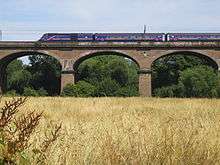 Looking north, July 2006 | |
| Coordinates | 51°30′39″N 0°20′39″W |
| Carries | trains, telecommunications via cables |
| Crosses | River Brent and Brent Valley |
| Locale | London (Hanwell/Southall) |
| Characteristics | |
| Design | arch bridge, viaduct |
| Total length | 270 metres (890 ft) |
| Width | 17 metres (56 ft) |
| Longest span | 21 metres (69 ft) |
| History | |
| Construction start | 1836 |
| Construction end | 1837 |

| |
The viaduct was the first major structural design by Isambard Kingdom Brunel, the first building contract to be let on the GWR project, and the first major engineering work to be completed. It was also the first railway viaduct to be built with hollow piers,[1] a feature much appreciated by a colony of bats which has since taken up residence within.
Design
Constructed of engineering brick, the 270-metre-long (890 ft) viaduct has eight semi-elliptical arches, each spanning 70 feet (21 m) and rising 5.3 metres (17 ft). It is 17 metres (56 ft) wide. The supporting piers are hollow and tapered, rising to projecting stone cornices that held up the arch centring during construction.[2]
When built, the viaduct was designed to carry two broad gauge tracks: the piers were 9.1 metres (30 ft) wide at ground level and 10 metres (33 ft) at deck level.
The contractor was the partnership of Thomas Grissell and Samuel Morton Peto. The cost was £40,000. The foundation works were carried out by William Brotherhood and his son Rowland.[3] The young Charles Richardson also worked here under Brunel, as one of his first works for the Great Western.[4]
As travel by rail became more popular and rail traffic grew, pressure mounted to have an additional local line. Also, the Gauge Act of 1846 decreed that George Stephenson's (narrower) standard gauge should be the standard used for all railways across the country. Therefore, in 1877 the viaduct was widened by the addition of an extra row of piers and arches on the north side. Then in 1892 the broad gauge track was converted to standard gauge, and this allowed enough width for four standard gauge tracks.[5]

for the catenary on the alternate centre lines of the viaduct's columns, thus maintaining symmetry of form.
On the central pier on the south side is a carving of the coat of arms of James Stuart Wortley Mackenzie, Lord Wharncliffe, who was chairman of the parliamentary committee that steered the passage of the GWR Bill through Parliament.[5]
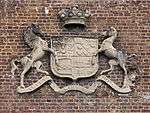
First viaduct to carry telegraph
Brunel was quick to see the possible advantages of the early electric telegraph system for use in running the railway. In 1838 he persuaded Sir Charles Wheatstone and William Fothergill Cooke to install their five-needle telegraph system between Paddington Station and West Drayton and to carry out experiments.[6] It proved to be useful, so the viaduct thus carried the world's first commercial electrical telegraph, on 9 April 1839.
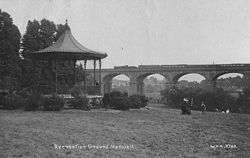
At first, the seven-core cables were carried inside cast iron pipes, on short wooden spikes, a few feet from the side of the railway line. But from January 1843, the public were treated to the sight of telegraph wires against the sky line, across the top of the viaduct, for the first time. Cooke had renegotiated the contract with the GWR and extended the telegraph to Slough, using a simpler two-needle instrument that could be supplied with just two wires suspended from porcelain insulators on poles.[7]
On 16 May 1843 the Paddington-to-Slough telegraph went public, becoming Britain's first public telegraph service. Despite being something of a publicity stunt for Cooke, it became very popular, and HM Government were frequently using it for communication with the royal household at Windsor Castle nearby.[7]
In early 1845, John Tawell was apprehended following the use of a needle telegraph message from Slough to Paddington on 1 January 1845. This is thought to be the first use of the telegraph to catch a murderer.
The message was:
- A murder has just been committed at Salt Hill and the suspected murderer was seen to take a first class ticket to London by the train that left Slough at 7.42pm. He is in the garb of a Kwaker with a brown great coat on which reaches his feet. He is in the last compartment of the second first-class carriage
As the telecommunication traffic grew, the viaduct came to carry one of the trunk routes for the transatlantic cables, and more recently fibre-optic cables.[8]
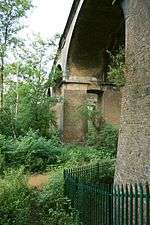
Public recognition
The viaduct was among the first structures to be listed, being defined as a Grade 1 listed building on 8 November 1949[1] (the legal framework for listing was introduced in 1947).
Sir Nikolaus Pevsner, CBE, the historian of art and architecture, said of it, "Few viaducts have such architectural panache."[9]
It is one of the key locations in the bid for historic parts of the original GWR main line from Paddington to be recognised as a World Heritage Site.[10]
On the nearby Uxbridge Road, an eighteenth-century coaching inn was renamed The Viaduct in its honour when the railway opened. This pub, which is itself listed as of local interest, still contains parts of the original stable block.[11]
Bat colony
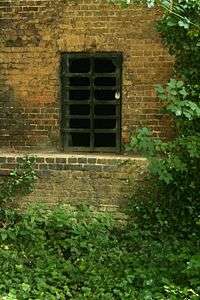
The hollow cavities within the structure of the supporting piers provide convenient roosting places for bats.[12] These 'bat caves' have been given legal protection under the Countryside Act (1981).[13] Bats are vulnerable to disturbance and the Act requires that only trained and licensed bat-workers may enter caves and other areas where bats roost.
The Parks and Countryside Service of the London Borough of Ealing, in conjunction with Network Rail and the London Bat Group, have worked to safeguard the colonies by providing entrance grilles and hibernation shelters for each roost.
It is not clear which species of bat is resident; indeed, there may be several. Identification usually requires capture and expert knowledge. However, the most likely candidate is Daubenton's bat (Myotis daubentonii), since this species forms colonies in caves, tunnels and under bridges, always near water (in this case, the River Brent), and is known to reside in other locations in west London.[14]
It is quite likely that this viaduct is the largest bat cave complex in the whole of London, and possibly the south of England, as no other roost approaching this size has so far been reported.
Location
The Wharncliffe Viaduct is best viewed from Brent Meadow on the south side, accessed from the Uxbridge Road, opposite Ealing Hospital. This is an area being maintained as a traditional hay meadow and is part of the Brent River Park.
The river Brent has marked the boundary between Hanwell and Southall since before the Domesday Book.
Time line
- 1836
A large body of Irish men engaged in constructing the Great Western Railway went to The Stag beerhouse, where a few Englishmen had assembled, and a row commenced. Hearing that the Rev. Dr. Walmisley, the rector, had dispatched a messenger to Brentford for the police, their rage was diverted to that worthy magistrate, whom they threatened to sacrifice to their fury. Three prisoners were sentenced to two months in the House of Correction by the magistrates, who sent a letter to the Company, and stated that unless something was done, it would be necessary to apply to the Government for a body of police or military, to be stationed at Hanwell.[15]
- 3 May 1838
First trains run. The first locomotives to cross were the Vulcan and the Aeolus built by Tayleur and Co., of Warrington and the more famous North Star, built by Robert Stephenson and Company at Newcastle-upon-Tyne.
- 4 June 1838
The line opened to the public.[16]
- 1839
Trains on the new railway left Hanwell for Paddington every morning at 8 and 11 am, and at 3 and 7 pm; also westwards for Slough and Maidenhead, at 9:30 am, and at 1:30, 4:30, and 8:30 pm.
Locally, it is often repeated to this day, that Queen Victoria so much enjoyed the view that she would have her train halt for a while on Brunel's spectacular viaduct over the river Brent.
- 1847
The engine of an Exeter Express lost a tyre from a 7-foot (2.1 m) drive wheel, near Southall. It killed two passers-by and derailed a goods train on the other track. As this happened at high speed, the express was unable to stop until it had passed over the Wharncliffe Viaduct.[17] [18]
- Second World War
With the industrial base of Britain being so dependent on its railway system, the viaduct was considered a strategic target by the Germans. Local people still remember the many attempts made by the Luftwaffe to destroy the viaduct. Had they succeeded, it would have severed the arterial link into and out of the West London industrial estates for many weeks – if not months. All raids, however, fell wide of their mark or the bombs failed to explode.
- 24 November 2002
A First Great Western train from Swansea to Paddington, travelling at approximately 120 mph (190 km/h), derailed shortly after it passed through a set of points close to Southall station. The train remained upright but travelled a further 2 miles (3.2 km), passing an oncoming High Speed Train, through Hanwell station, and over Wharncliffe Viaduct before coming to a halt. There were no injuries to the 450 passengers on board, but the driver had to be treated for shock.[19]
See also
References
- Historic England (17 June 2000). "Wharncliffe Viaduct (Grade 1 Listing) (1358811)". National Heritage List for England. Retrieved 20 June 2007.
- "Wharncliffe Viaduct". Engineering Timelines. Retrieved 19 June 2007.
- Leleux, Sydney A. (1965). Brotherhoods, Engineers. David & Charles. p. 10.
- Jones, Stephen K. (2009). Brunel in South Wales. III: Links with Leviathans. Stroud: The History Press. p. 48. ISBN 9780752449128.
- A History of the County of Middlesex (1962). Hanwell: Introduction. Vol 3: Shepperton, Staines, Stanwell, Sunbury, Teddington, Heston and Isleworth, Twickenham, Cowley, Cranford, West Drayton, Greenford, Hanwell, Harefield and Harlington, pp. 220–24. Date accessed: 19 June 2007.
- Archives in London – Wheatstone (accessed 22 June 2007)
- Distant Writing – Cooke & Wheatstone (Accessed 22 June 2007)
- Atlantic Cable Archived 20 August 2007 at the Wayback Machine
- Pevsner N B L (1991). The buildings of England, London 3: North-West. ISBN 0-300-09652-6
- The United Nations Educational, Scientific and Cultural Organization (UNESCO) The Great Western Railway: Paddington-Bristol (selected parts) Accessed 19 June 2007
- "The Viaduct Pub, Hanwell". – A brief history. The Viaduct. Archived from the original on 27 September 2007. Retrieved 19 June 2007.
- "Hanwell parks and open spaces". (Churchfield's Recreation Ground). Ealing Council. Archived from the original on 30 September 2007. Retrieved 20 June 2007.
- "Countryside Act, 1981: Schedule 5 (Animals)". Joint Nature Conservation Committee (JNCC). Retrieved 20 June 2007.
- "Bats of London". London Bat Group. Retrieved 20 June 2007.
- Sharpe, Sir Montagu (1924). Some accounts of bygone Hanwell. Middlesex, London. UK: The Brentford Printing and Publishing Coy. Ltd. p. 97.
- The Times, Saturday, 4 June 1938; pg. 9; issue 48012; col C
- Brunel University West London. Broad gauge trilogy Archived 12 June 2007 at the Wayback Machine. Accessed 23 June 2007
- Oates, Jonathan. Southall and Hanwell. Gloucestershire GL5 2QG UK: Tempus Publishing Ltd.CS1 maint: location (link)
- "Rail bosses face safety charges". BBC News. BBC. Retrieved 22 September 2017.
External links
| Wikimedia Commons has media related to Wharncliffe Viaduct. |
- Historic England. "Wharncliffe Viaduct (1358811)". National Heritage List for England.
- "Wharncliffe Viaduct, John Bourne, 1845" – drawing commissioned by the GWR for a book of stations and railway infrastructure.
- The London Bat Group Accessed 2007-06-18
- Photo of grille preventing human access to bat roosts
- Photo of information board under the viaduct.